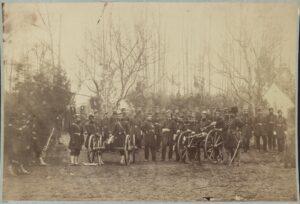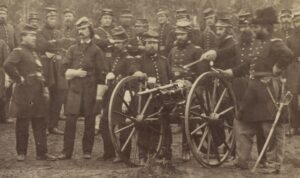Officers of the 96th Pennsylvania Infantry (1861)
4 August 2024
This lovely image was probably taken at the home of the 96th Pennsylvania Volunteers, Camp Northumberland, near Alexandria, VA between December 1861 and March 1862. These, then, are the officers of the regiment at that time and place.
Particularly interesting are the two wheeled weapons at the front of the group.
On the right is a Union Repeating Gun (also known as an Ager Gun or the coffee mill gun). A few of these hand-cranked repeating guns were produced in 1861; apparently President Lincoln was intrigued by their potential and had 10 built. As many as 50 others where produced later. They saw very limited use during the war, and I’ve seen no mention of this one’s actual use by the 96th.
Gathered around that gun are the field and some of the staff officers of the regiment.
In the foreground to our right, left hand on hip, wearing a plumed Hardee hat, is Colonel Henry Lutz Cake, organizer and commander of the regiment. He was an excellent combat leader, which was particularly apparent in action at Crampton’s Gap on 14 September 1862.
Next to him is Lieutenant Colonel Jacob Gellert Frick, a Mexican War veteran. By Antietam in September 1862 he was Colonel of his own regiment, the 129th Pennsylvania. He was later awarded the Medal of Honor for his work at Fredericksburg and Chancellorsville.
To Frick’s right is the Chaplain, the Reverend Samuel Fisher Colt (1817-1893), pastor of the Presbyterian Church in Pottsville. He was discharged in July 1862 and was not on the Maryland Campaign.
Next along to our left is Major Lewis J Martin, a coal mining engineer from Pottsville. He was mortally wounded by a gunshot to his head at Crampton’s Gap and died soon after.
I have not positively identified the next 4 men, but the man with his hand on the wheel may be Dr. Daniel Webster Bland, who was the regiment’s Surgeon from organization to muster out, in October 1864, and later Sixth Army Corps Medical Inspector. I have not confirmed his presence in Maryland in 1862.
The tall man second from left with the luxuriant mustache is probably Assistant Surgeon Washington George Nugent. He had prior service in the 3-month 14th Pennsylvania. He resigned from the 96th on 12 September 1862 to accept appointment as the Surgeon of the 9-month 126th Pennsylvania Infantry, afterward as Surgeon of the 20th Regiment, Emergency Militia of 1863, and then was a contract surgeon at the Fort Delaware post & prison hospital to the end of the war.
The artillery piece in that picture is part of a fascinating story dating to the early organization of the 96th Pennsylvania in September 1861.
A group of Pottsville First Defender veterans, members of the Good Intent Fire Company, formed the Good Intent Light Artillery under Captain Lessig.
The battery … was to be short lived, that is as far as the name was concerned. The members were unable to secure any ordnance to drill with and finally the “boys” decided to swipe brass and make a cannon themselves. Piece by piece they scraped together the brass while some poor, unsuspecting victim scratched his head and wondered at the mysterious disappearance of some article of brass from his shop or household. When enough had been secured the brass was melted and molded into a fine cannon by Geo. W. Snyder …
The Good Intent Battery would undoubtedly have become famous, as the members did, but for an unlooked for occurrence. The 96th regiment had been recruited and lacked but one company. The Good Intent Battery was mustered into this regiment and the members then became infantrymen and “shouldered the cannon” as they remarked for ever afterward. The precious cannon was taken along with the 96th Regt., but was finally turned over to a New England Battery [June 1862], and that was the last seen or heard of it.
Those would-be artillerists became Company C of the 96th, and their officers are seen here around “their” cannon. From left to right, in the foreground, they are:
First Lieutenant Isaac E Severn. He’d served as a Private and Corporal in the Washington Artillery, which became Company H of the 25th Pennsylvania Infantry, from April to July 1861. I can’t specifically place Severn on the Maryland Campaign of 1862, though he may well have been present. He was promoted to Captain of his Company in November 1862 and mustered out with them in October 1864.
Captain William Henry Lessig, later Major, Lieutenant Colonel, and finally Colonel of the 96th Pennsylvania Infantry.
And, I think, 2nd Lieutenant Samuel Rex Russel, with his hand on the breech. He was promoted to Captain of Company H in May 1863, and served out his term to October 1864.
Notes
The photograph of the officers of the 96th is in the collection of the Library of Congress.
The quote above about the Good Intent Light Artillery is from a veteran of the unit in the Pottsville Daily Republican of 18 April 1900, found in a fantastic blog post by Stu Richards.




Please Leave a Reply